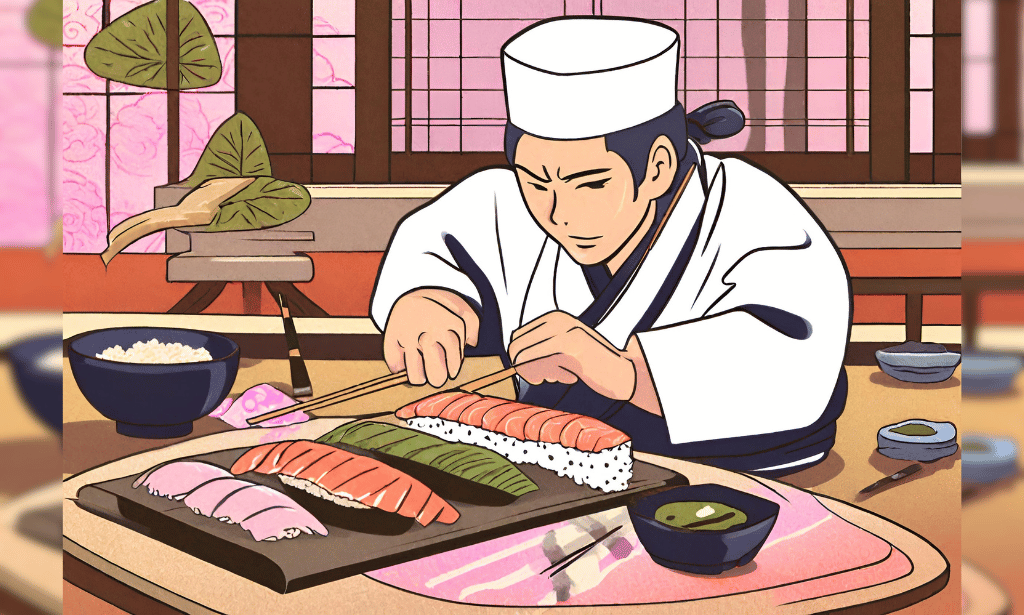The History of Sushi
Sushi, a quintessential Japanese cuisine, has a rich and intriguing history that spans centuries. It's more than just raw fish and rice; it's a culinary art form that has captivated people worldwide. Let's delve into the fascinating journey of sushi from its humble beginnings to its status as a global culinary phenomenon.

Early History of Sushi
Origins in Southeast Asia
Sushi's story begins in Southeast Asia, where people preserved fish by fermenting it with rice and salt. This process, known as lacto-fermentation, helped preserve the fish and made it safe to eat over time. The rice was discarded, and only the fish was consumed.
Introduction to Japan
Sushi made its way to Japan around the 8th century, likely through Chinese influence. Japanese people initially used fermented rice to preserve fish, but they eventually started consuming both the rice and the fish, leading to the birth of sushi as we know it today.
Evolution of Sushi in Japan
Narezushi and Namanare
The earliest form of sushi in Japan was called narezushi. Fish was fermented with rice for months, resulting in a pungent flavor. Over time, narezushi evolved into namanare, where the fermentation period was shortened to a few weeks, resulting in a milder taste.
Introduction of Vinegar Rice
During the Muromachi period (14th to 16th centuries), Japanese chefs began seasoning rice with vinegar, salt, and sugar to enhance its flavor. This innovation revolutionized sushi, making it more palatable and enjoyable.
Edo Period and the Birth of Modern Sushi
Edo (Tokyo) and Sushi Culture
The Edo period (17th to 19th centuries) marked a significant turning point for sushi. Street vendors in Edo (present-day Tokyo) began selling nigiri sushi, a hand-pressed mound of vinegar rice topped with fresh fish. This portable and affordable snack quickly gained popularity among the masses.
Development of Nigiri Sushi
Nigiri sushi became synonymous with Japanese cuisine during the Edo period. Skilled chefs perfected the art of crafting nigiri, using the freshest ingredients and precise techniques to create a harmonious balance of flavors and textures.
Sushi Spreads Globally
Sushi's Journey to the West
In the mid-20th century, sushi began making its way to the West, initially through Japanese immigrants in the United States. Sushi bars and restaurants started popping up in major cities, introducing Westerners to this exotic delicacy.
Adaptations and Variations
As sushi gained popularity worldwide, it underwent various adaptations and innovations to suit local tastes and preferences. From California rolls to spicy tuna rolls, sushi has evolved into a diverse and dynamic culinary genre.
Contemporary Sushi Culture
Sushi Restaurants and Chefs
Today, sushi is not just a meal; it's an experience. High-end sushi restaurants around the world boast master chefs who meticulously craft each piece of sushi with precision and skill. Diners can enjoy omakase (chef's choice) menus that showcase the chef's creativity and expertise.
Popularity and Trends
Sushi's popularity shows no signs of waning. It has become a symbol of sophistication and luxury, with sushi bars frequented by celebrities and food enthusiasts alike. New trends, such as sustainable seafood and fusion sushi, continue to reshape the sushi landscape.
Health Benefits of Sushi
Nutritional Value
Sushi is not only delicious but also nutritious. It's rich in omega-3 fatty acids, protein, vitamins, and minerals, making it a healthy choice for seafood lovers. Additionally, the vinegar rice used in sushi may aid in digestion and promote gut health.
Potential Health Risks
While sushi offers many health benefits, there are some potential risks to consider, such as mercury contamination in certain types of fish and the use of high-calorie sauces and condiments. It's essential to consume sushi in moderation and choose reputable restaurants that prioritize food safety.
Conclusion
The history of sushi is a testament to the ingenuity and creativity of Japanese chefs. From its humble beginnings as a preservation method to its status as a global culinary phenomenon, sushi has captured the hearts and taste buds of people around the world. Whether you're a sushi aficionado or a curious newcomer, there's no denying the allure of this iconic Japanese dish.
FAQs
Is sushi always made with raw fish?
No, sushi can be made with a variety of ingredients, including cooked seafood, vegetables, and even fruit.
What's the difference between sushi and sashimi?
Sushi refers to any dish made with vinegared rice, while sashimi specifically refers to thinly sliced raw fish or seafood served without rice.
Is it safe to eat sushi during pregnancy?
Pregnant women should avoid certain types of sushi, such as those made with raw or undercooked fish, to reduce the risk of foodborne illnesses.
What is the proper way to eat sushi?
Traditionally, sushi is eaten with fingers rather than chopsticks to fully experience the texture and flavor of each piece.
Are there vegetarian options available at sushi restaurants?
Yes, many sushi restaurants offer vegetarian rolls made with ingredients like avocado, cucumber, and tofu.

You must be logged in to post a comment.